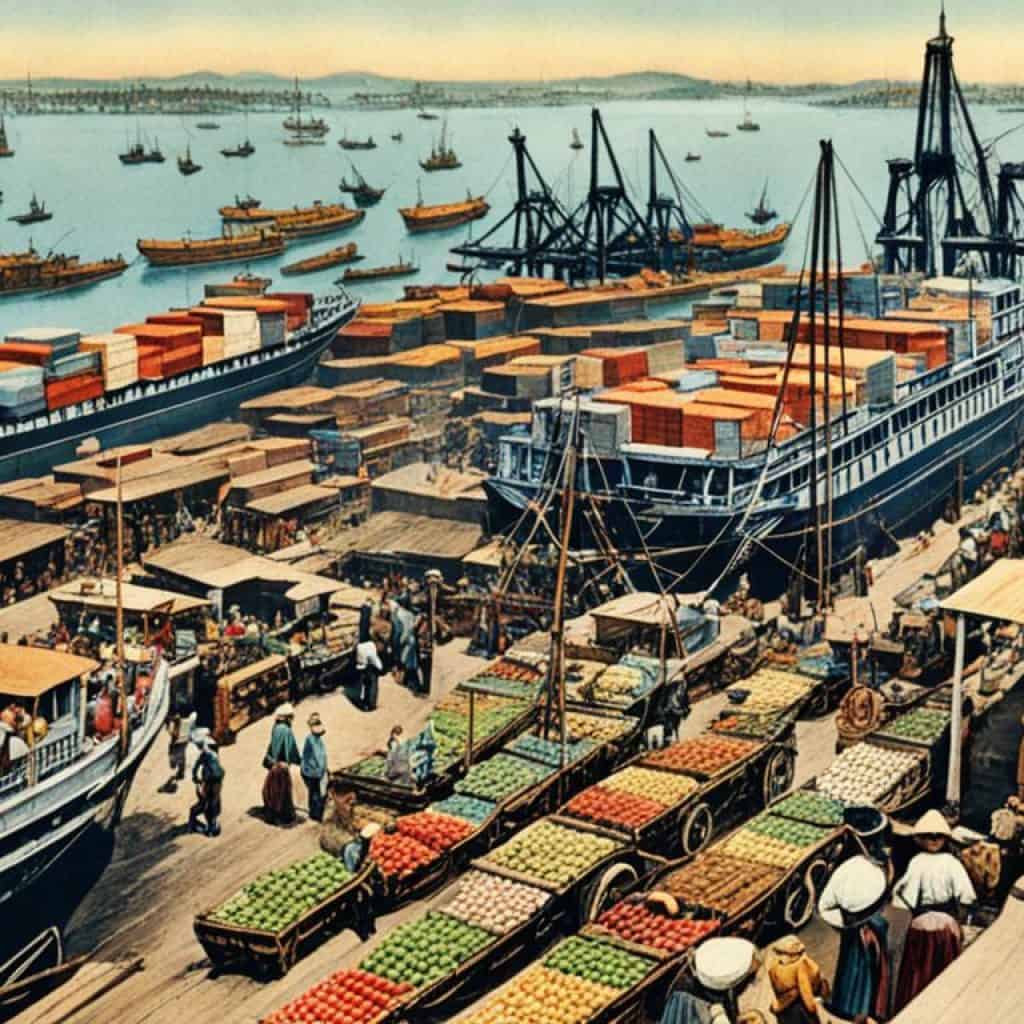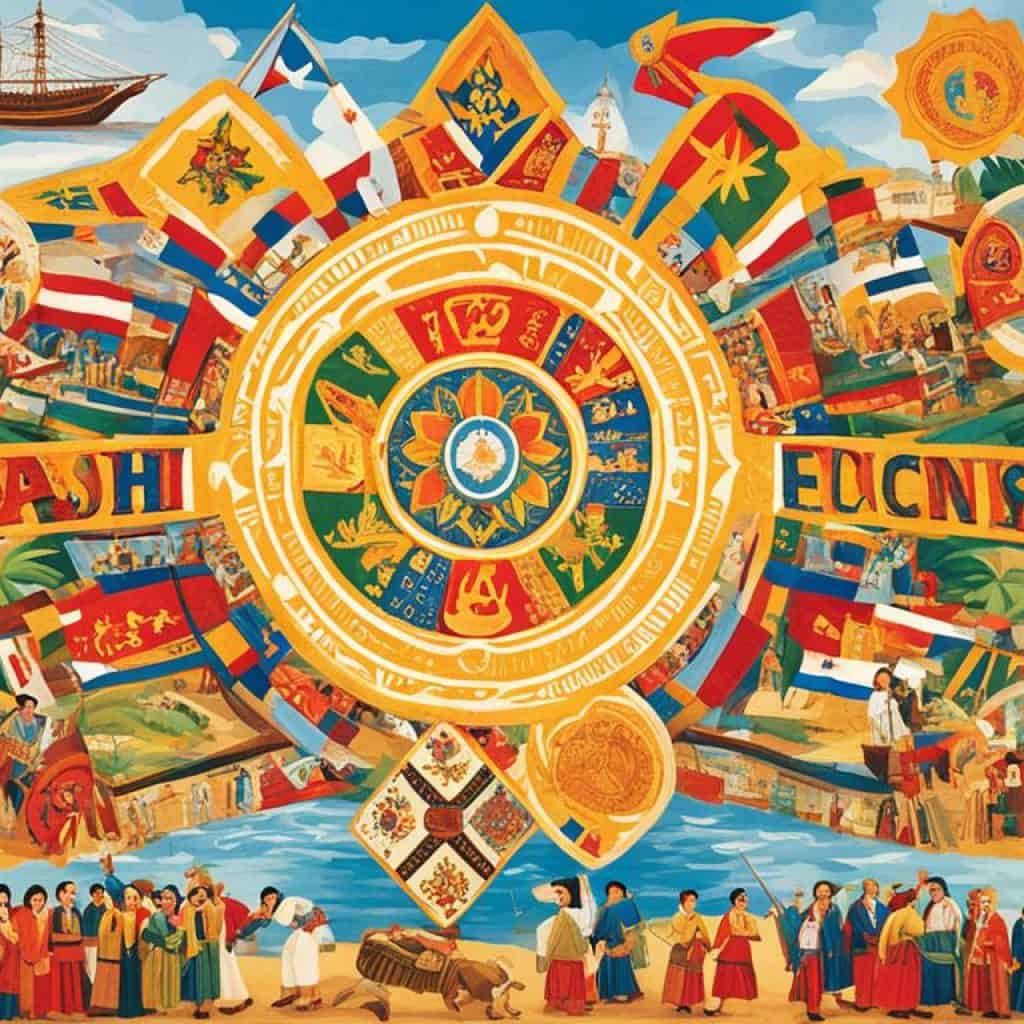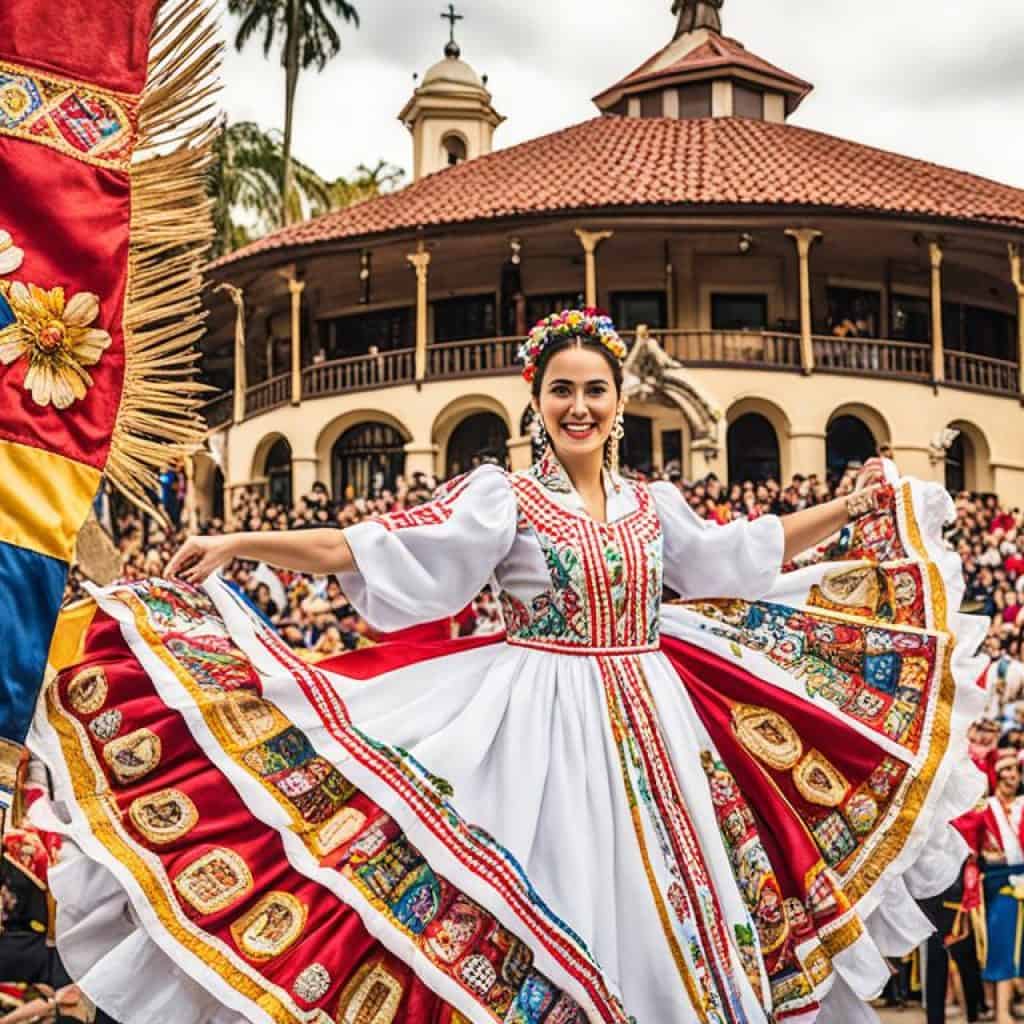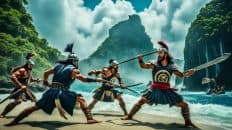Have you ever wondered how Spanish colonization shaped the history and culture of the Philippines? How did it impact the economy and society of this Southeast Asian archipelago? Delve into the complexities of Spanish colonization in the Philippines and discover the profound and lasting effects it had on this nation.
Key Takeaways:
- Spanish colonization in the Philippines began in 1521 with the arrival of Ferdinand Magellan and ended in 1898 with the defeat of Spain by the United States.
- The Spanish established permanent settlements, including Manila, and implemented the encomienda system, bringing Catholicism to the indigenous population.
- Spanish rule varied across the islands, with resistance from Muslim populations in the south preventing complete control.
- Spanish colonization had a lasting impact on Philippine culture, history, and society, shaping everything from religion and language to architecture and cuisine.
- The desire for independence eventually led to the Philippine Revolution and the end of Spanish colonization.
The Early Spanish Expeditions and Establishment of Settlements
Spanish colonization in the Philippines began with the arrival of Ferdinand Magellan in 1521. Magellan led the first Spanish expedition to the Philippines, making landfall on the island of Cebu. However, his journey was plagued with challenges, and it wasn’t until the arrival of Miguel López de Legazpi that the Spanish were able to establish a permanent settlement.
After multiple unsuccessful expeditions, Miguel López de Legazpi successfully established the first permanent Spanish settlement in Cebu in 1565. This settlement marked the beginning of Spanish presence in the Philippines, laying the foundation for future colonization efforts.
“We shall conquer this land and convert its people to Christianity.”
With the establishment of the Spanish settlement in Cebu, the Spanish turned their attention towards further expanding their control. In 1571, the Spanish city of Manila was founded, solidifying Spanish dominance over the coastal and lowland areas of the Philippines.
The Spanish soldiers who accompanied López de Legazpi were not alone in their mission. Friars from various religious orders also joined them, with the aim of converting the local population to Roman Catholicism. This integration of religious and political objectives played a crucial role in shaping the nature of Spanish colonization in the Philippines.
Despite their efforts, the Spanish were unable to exert complete control over the Muslim populations in Mindanao and Sulu, known as the Moros. These Muslim communities had already established a strong presence in the region before the arrival of the Spanish and continued to resist Spanish rule.
Spanish Political and Economic Control
During Spanish colonization, the Philippines was governed by a colonial government led by a powerful governor-general. This centralized authority allowed the Spanish to exercise their control over the archipelago effectively. Under the Spanish colonial government, the encomienda system was initially implemented, where tribute payers were subjected to abuse by encomenderos. However, by the late 17th century, the Spanish abandoned this system and replaced it with their own civil and military governors.
Manila emerged as the political, commercial, and ecclesiastical capital of the Philippines. Its strategic location and deep harbor facilitated trade, making it incredibly significant in the region. Manila’s commercial importance was further solidified by the galleon trade with Acapulco, Mexico. This trade route allowed for the exchange of goods between Asia and the Americas, contributing to Manila’s economic dominance.
Moreover, Manila became home to a thriving Chinese community. The Chinese merchants and traders played a crucial role in Manila’s commerce, dominating business activities and contributing to the city’s cultural diversity. Their presence further strengthened the economic ties between China and the Philippines, creating a vibrant commercial hub.

Manila's Commercial Importance
“Manila’s strategic location and the galleon trade with Acapulco made it a significant center of commerce, attracting merchants from various parts of the world.”
The Chinese Community in Manila
The Chinese community in Manila had a substantial influence on the city’s economic landscape. They were prominent traders, entrepreneurs, and artisans who contributed to the growth and prosperity of Manila during the Spanish colonial period. Their presence brought in diverse cultural practices and traditions, enriching the fabric of Philippine society.
“The Chinese community in Manila dominated commerce, contributing to the economic vibrancy of the city and enhancing its cultural diversity.”
The Spanish colonial government and the economic activities in Manila played a significant role in shaping the political and economic landscape of the Philippines. The Spanish authorities, governor-general, and the Chinese community in Manila were pivotal in maintaining Spanish control over the archipelago and establishing Manila as a key commercial hub in Southeast Asia.
The Power of the Church in Spanish Colonization
The Spanish clergy played a significant role in the process of Spanish colonization in the Philippines. During this time, priests and friars held immense influence and outnumbered civil officials in the provinces. They were not only religious authorities but also cultural conduits, with a profound impact on the local population.
The primary cultural goal of the Spanish clergy was to fully Christianize and Hispanize the Filipino population. They sought to convert the indigenous people and assimilate them into the Spanish culture and way of life. Local religions and spiritual practices were suppressed, and Roman Catholicism was forcibly imposed as the dominant faith.
“The propagation of Catholicism is the main purpose, the soul of the colonization enterprise.”
However, as the Spanish clergy made efforts to convert the Filipino population, they encountered challenges and witnessed unintended consequences. With the growing number of Christian converts, the zeal of the clergy eventually waned. As a result, some ancient beliefs and customs began to resurface under the guise of Roman Catholicism.
Indigenous traditions, rituals, and customs managed to regain influence, blending with elements of Spanish culture. This syncretism allowed for the preservation of certain aspects of pre-Spanish Filipino culture, despite the overwhelming presence of Spanish influence.
Conversion of the Filipino Population: Statistics
| Year | Number of Converted Filipinos |
|---|---|
| 1600 | 50,000 |
| 1700 | 300,000 |
| 1800 | 1,000,000 |
Preservation of Pre-Spanish Filipino Culture: Examples
- Incorporation of indigenous rituals and dances into religious festivals
- Retaining indigenous terms and concepts within the Catholic liturgy
- Adaptation and integration of native music and instruments in religious ceremonies
- Maintaining traditional healing practices alongside Catholic beliefs
While the Spanish clergy played a dominant role in shaping the religious and cultural landscape of the Philippines, the preservation of pre-Spanish Filipino culture showcases the resilience of the indigenous population. It highlights the ability to adapt, negotiate, and blend diverse influences, resulting in a rich and vibrant cultural heritage that continues to thrive today.
Socioeconomic Changes Under Spanish Rule
During the period of Spanish colonization in the Philippines, significant socioeconomic changes took place, leaving a lasting impact on the country’s agriculture, class structure, and governance. The Spanish introduced new agricultural practices and implemented policies that led to the rise of a new noble class known as the principalia.
One of the key impacts of Spanish colonization was the transformation of agricultural practices. The Spanish friars, who played a vital role in the colonization process, promoted a shift from shifting cultivation to more intensive sedentary farming methods. Through their guidance, the friars introduced Western agricultural techniques, such as the cultivation of cash crops and the use of irrigation systems. This shift not only increased agricultural productivity but also brought about changes in land ownership and labor systems.
The introduction of the Western concept of absolute ownership of land had profound socioeconomic consequences. The Spanish policies reinforced existing class differences and created a stark divide in land ownership. The pre-Spanish noble class, known as the principalia, seized the opportunity presented by the new land ownership system to claim the fields cultivated by their retainers. This consolidation of land ownership by the principalia further solidified their power and influence in the society.
“The principalia played a significant role in the friar-dominated local government, further entrenching their position in society.”
The rise of the principalia had far-reaching implications, not only in the realm of agriculture but also in governance. They became the intermediaries between the friars and the local Filipino communities, overseeing the collection of tribute and the implementation of Spanish policies at the local level. Their influence extended beyond agriculture and played a vital role in the maintenance of Spanish control in the Philippines.
To better visualize the socioeconomic changes brought about by Spanish colonization, let’s take a closer look at the transformation of the Philippine society during this period:
| Aspect | Pre-Spanish Period | Spanish Colonial Period |
|---|---|---|
| Agricultural Practices | Primarily shifting cultivation | Shift to sedentary farming under the guidance of Spanish friars |
| Land Ownership | Communal, with flexible boundaries | New concept of absolute ownership, leading to consolidation of land by the principalia |
| Class Structure | Loosely defined, minimal class distinctions | Emergence of the principalia as the new noble class |
| Governance | Indigenous systems of governance | Principalia serving as intermediaries between the friars and the local communities |
The socioeconomic changes brought about by Spanish rule had a profound and long-lasting impact on the Philippines. These changes reshaped the agricultural landscape, reinforced class divisions, and gave rise to a new aristocratic class. Understanding these transformations is crucial to comprehending the complex socioeconomic dynamics that continue to influence contemporary Philippine society.
The Spanish Colonial Period in Philippine History
The Spanish colonial period in the Philippines lasted from 1565 to 1898. During this time, the Philippines was governed as the Captaincy General of the Philippines, under the Viceroyalty of New Spain. The Spanish ruled directly, establishing their presence through colonization, the conversion of the indigenous population to Catholicism, and economic control.
The Spanish colonial period began with the arrival of Miguel López de Legazpi in 1565, who established the first permanent Spanish settlement in Cebu. The Spanish focused on expanding their influence and control, leading to the founding of Manila in 1571, which became the capital city.
The Philippines was a significant outpost of the Spanish Empire, serving as a strategic trade and military hub in Southeast Asia. The Spanish established a strong presence in Manila, which became a center of commerce and played a crucial role in the galleon trade between Asia and the Americas.
The Captaincy General of the Philippines was under the jurisdiction of the Viceroyalty of New Spain, which encompassed present-day Mexico and Central America. The Viceroyalty was created by the Spanish Crown to administer and control its vast territories in the Americas and Asia.
Table: Spanish Colonial Period in the Philippines
| Time Period | Event |
|---|---|
| 1565 – 1571 | Establishment of Spanish settlements in the Philippines, beginning with Cebu and culminating in the founding of Manila. |
| 1571 – 1898 | Spanish rule over the Captaincy General of the Philippines. |
| 1821 | Independence of the Mexican Empire from Spain, leading to changes in the governance of the Philippines. |
| 1898 | Defeat of Spain by the United States in the Spanish-American War, marking the end of Spanish colonial rule in the Philippines. |
The Spanish colonial period in the Philippines had a significant impact on the country’s culture, society, and history. It brought about the introduction of Catholicism, the Spanish language, and European customs and traditions. Spanish influence can still be seen today in the architecture, language, and religion of the Philippines.
The Spanish colonial period ended with the defeat of Spain by the United States. It marked the beginning of a new chapter in Philippine history, as the country went on to struggle for independence and forge its own path.
Ethnolinguistic Diversity in Spanish Colonization
During the period of Spanish colonization in the Philippines, the archipelago was characterized by immense ethnolinguistic diversity. With over 150 cultural, ethnic, and linguistic groups, the Philippines showcased a rich tapestry of traditions, languages, and belief systems.
The Spanish encountered a variety of indigenous belief systems in their quest for domination. These belief systems included nature worship, shamanism, and ancestor worship, each deeply rooted in the cultural practices of different indigenous communities.
As Spain imposed its rule, one of the significant impacts was the introduction of Catholicism to the indigenous population. Catholicism served as a catalyst for the transformation and suppression of local traditions. The Catholic Church became a central institution in Spanish colonization and played a crucial role in reshaping the spiritual and cultural landscape of the Philippines.
The impact of Catholicism varied across different regions and communities. While some areas fully embraced the new religion, others managed to incorporate elements of their pre-Spanish belief systems within the framework of Catholicism. This syncretic approach allowed certain communities to maintain a distinct cultural identity while adapting to the new religious practices.
Impact on Indigenous Belief Systems
The imposition of Catholicism marked a significant shift in the indigenous belief systems in the Philippines. Traditional beliefs and practices were often suppressed or transformed to align with the teachings of Catholicism. However, it is essential to note that the impact varied from region to region and the extent to which indigenous beliefs were assimilated into the new religious framework.
“The encounter between Catholicism and indigenous belief systems in the Philippines led to a complex and multifaceted cultural landscape, where elements of both coexist and intertwine.” – Cultural historian, Maria Santos
Some indigenous communities managed to preserve certain aspects of their pre-Spanish belief systems by integrating them with Catholic rituals and practices. This syncretism allowed for the preservation of cultural traditions and the continued reverence for ancestral spirits and nature.
Ethnolinguistic Diversity and Catholic Conversion
Due to the vast ethnolinguistic diversity in the Philippines, the process of Catholic conversion differed from one community to another. The Spanish clergy faced the challenge of communicating and converting across multiple languages and cultural contexts.
The impact of Catholic conversion extended beyond religious practices. With the introduction of the Spanish language, many indigenous communities adopted Spanish as a means of communication. The Spanish clergy played a pivotal role in facilitating this linguistic shift, making the Catholic teachings accessible to a broader population.
The conversion to Catholicism also played a role in the social and economic integration of indigenous communities into the colonial society. By embracing the new religion, individuals gained access to education, economic opportunities, and social mobility within the Spanish-dominated hierarchy.
| Impact of Catholicism on Ethnolinguistic Diversity | Examples |
|---|---|
| Transformation of indigenous rituals | Adaptation of traditional harvest rituals within Catholic feast days |
| Language shift | Adoption of Spanish as a means of communication in previously distinct linguistic groups |
| Social integration | Access to education and economic opportunities through affiliation with the Catholic Church |
| Preservation of cultural heritage within Catholic practices | Incorporation of indigenous symbols and beliefs into Catholic rituals and ceremonies |
The interplay between ethnolinguistic diversity, indigenous belief systems, and the impact of Catholicism created a unique cultural landscape in the Philippines. This diversity continues to shape the country’s identity and underscores the complex legacy of Spanish colonization.

Spanish-Moro Conflict in the Southern Philippines
The southern half of the Philippines, particularly the Muslim-majority areas, presented formidable challenges to Spanish colonization. The Spanish-Moro Wars marked a series of long-standing hostilities between the Spanish and Muslim populations. Prior to the arrival of the Spanish, the Muslim communities had already established a strong Islamic presence in the region, resisting any foreign attempt at control.
“The Spanish-Moro Wars were characterized by fierce resistance from the Muslim population, determined to defend their autonomy and resist Spanish rule at all costs.”
Despite their efforts, the Spanish authorities were unable to fully dominate or govern these areas. Instead, a lasting division between the Muslim and Christian populations emerged, shaping the history and culture of the southern Philippines.
Resistance and Revolutionary Movements
Throughout the Spanish colonial period, the Philippines witnessed numerous instances of resistance and revolutionary movements against Spanish rule. Brave Philippine revolutionaries fought valiantly for the freedom and independence of their motherland.
Gabriela and Diego Silang
Gabriela and Diego Silang were prominent figures in the resistance against Spanish oppression. They led the fight for an independent Ilocano nation in the northern part of the Philippines. Their courageous efforts inspired many Filipinos to rise up against colonial rule.
Andrés Bonifacio and Emilio Jacinto
Andrés Bonifacio, along with Emilio Jacinto, played a pivotal role in the revolutionary movements that aimed to liberate the Philippines from Spanish dominion. They founded the Kataastaasan Kagalanggalang na Katipunan ng mga Anak ng Bayan (KKK), a secret society that called for armed struggle and nationalism.
“The Revolution is not an apple that falls when it is ripe. You have to make it fall.” – Andrés Bonifacio
José Rizal
José Rizal, a revered national hero, used his writings to expose the abuses inflicted by the colonial government and agitated for reforms. His novels, such as Noli Me Tangere and El Filibusterismo, awakened the consciousness of the Filipino people and paved the way for their aspirations for independence.
“It is a useless life that is not consecrated to a great ideal. It is like a stone wasted on the field without becoming a part of any edifice.” – José Rizal
The sacrifices and contributions of these Philippine revolutionaries paved the way for the eventual liberation of the Philippines from Spanish rule. Their unwavering dedication to freedom and justice serves as a testament to the indomitable spirit of the Filipino people.
Spanish Influence on Philippine Culture
One of the most notable influences of Spanish colonization on Philippine culture is the dominant presence of Catholicism. The Spanish missionaries brought the Catholic faith to the islands and converted the indigenous population. Today, Catholicism remains the predominant religion in the Philippines, with Catholic rituals and traditions integrated into Filipino religious practices.
“The Spaniards have given them their very own God, but the Filipinos have given the God new clothes.”
The arts, literature, music, and cuisine in the Philippines also reflect the fusion of indigenous and Spanish influences. Spanish colonization introduced European artistic styles and techniques, which blended with the rich artistic traditions of the indigenous peoples. This fusion is evident in traditional Filipino dances, such as the Tinikling, which incorporates Spanish-influenced footwork and indigenous rhythms.
The Spanish language became widely spoken during the colonial period and remains an integral part of the Filipino linguistic landscape. Many Spanish loanwords and expressions are still used in the Filipino language today, showcasing the lasting influence of Spanish colonization.
Furthermore, Spanish surnames are common among Filipinos, a testament to the influence of Spanish naming conventions. The adoption of Spanish surnames is a result of a decree issued during Spanish colonial times that required Filipinos to adopt Spanish surnames for official documentation.
To fully appreciate the fusion of indigenous and Spanish elements in Philippine culture, let’s take a closer look at some examples:
Cuisine
Philippine cuisine is a harmonious blend of indigenous flavors and Spanish culinary techniques. The Spaniards introduced ingredients such as tomatoes, potatoes, garlic, and onions, which became integral to Filipino cooking. Traditional Filipino dishes like adobo, sinigang, and lechon have evolved from the fusion of indigenous ingredients and Spanish cooking methods.
Literature
The impact of Spanish colonization on Philippine literature is evident in the use of Spanish language and themes in Filipino literary works. Prominent Filipino writers during the Spanish colonial period, such as Jose Rizal and Pedro Paterno, expressed their nationalist sentiments and desire for Filipino identity through their Spanish-language writings.
Architecture
Spanish colonial architecture left a lasting impression on the Philippine landscape. Churches and buildings constructed during the Spanish colonial period incorporated European architectural styles, such as Baroque and Neoclassical designs. Examples of Spanish-influenced structures can be found in the UNESCO World Heritage-listed Baroque Churches of the Philippines.
Visual Arts
The fusion of indigenous and Spanish artistic traditions is evident in Philippine visual arts. Traditional weaving techniques, pottery, and woodcarving were influenced by Spanish aesthetics, resulting in unique art forms that encapsulate the cultural diversity of the Philippines.

All these examples illustrate the rich and vibrant culture that emerged from the fusion of indigenous and Spanish elements in the Philippines. Spanish colonization may have brought about significant changes, but it also contributed to the diversity and resilience of Filipino culture.
| Spanish Influence on Philippine Culture | Examples |
|---|---|
| Cuisine | Adobo, sinigang, lechon |
| Literature | Writings of Jose Rizal, Pedro Paterno |
| Architecture | Baroque Churches of the Philippines |
| Visual Arts | Traditional weaving, pottery, woodcarving |
Spanish Colonization and the Economy
The Spanish colonization of the Philippines had a significant impact on the country’s economy. One of the key factors that shaped economic development during this period was the galleon trade between Manila and Acapulco, Mexico. This trade route played a crucial role in establishing the commercial dominance of Manila and brought immense wealth to the city.
Through the galleon trade, Manila became a center for the exchange of Chinese goods, such as silk, porcelain, and spices, for Mexican silver. The influx of silver enriched Manila and attracted a large Chinese community, which contributed to the city’s economic prosperity. The Chinese community played a vital role in commerce and trade, further enhancing Manila’s economic dominance.
In addition to the galleon trade, Spanish colonial policies and institutions shaped economic practices in the Philippines. The Spanish government implemented various policies to promote agricultural development and maximize profits. The encomienda system, although eventually abolished due to its exploitative nature, initially contributed to the emergence of a merchant class and fostered agricultural changes.
The establishment of Spanish institutions, such as the cabildo (town council) and the consulado (guild of merchants), also played a crucial role in shaping the economy. These institutions regulated trade, ensured the fair distribution of goods, and facilitated economic growth within the colonial framework.
| Spanish Impact on the Philippine Economy | Galleon Trade | Economic Dominance of Manila |
|---|---|---|
| Enriched Manila through the exchange of Chinese goods for Mexican silver | Established Manila as the center of trade between Asia and the Americas | Attracted a large Chinese community and facilitated economic growth |
| Shaped economic practices through colonial policies | Enhanced commercial opportunities and stimulated economic development | Strengthened Manila’s position as the economic hub of the Philippines |
| Promoted the emergence of a merchant class | Facilitated the exchange of goods between the East and the West | Established Spanish institutions that regulated trade and fostered economic growth |
The Spanish impact on the Philippine economy during the colonial period cannot be understated. The galleon trade and the economic dominance of Manila brought unprecedented wealth and opportunities to the city. Spanish colonial policies and institutions further molded the economic landscape, fostering the emergence of a merchant class and shaping agricultural practices. These economic legacies continue to influence the Philippines to this day.
Legacy and Aftermath of Spanish Colonization
The lasting legacy of Spanish colonization in the Philippines can still be felt and seen today. Spanish architectural influences have left an indelible mark on the country, with churches and buildings showcasing intricate designs that dot the Philippine landscape.
The Roman Catholic Church, introduced by the Spanish, remains a dominant religious institution in the Philippines. Its teachings and rituals have become deeply ingrained in Filipino culture, shaping the beliefs and values of the people.
In addition to religion, Spanish surnames continue to be prevalent among Filipinos, serving as a reminder of the country’s colonial past. Many Filipinos proudly bear Spanish surnames, a testament to the enduring cultural and familial ties to the time of Spanish rule.
“The struggle for independence from Spain eventually led to the Philippine Revolution, a pivotal moment in Philippine history. This revolution ignited the fire of nationalism and paved the way for the eventual independence of the Philippines from Spanish rule.”
However, it is important to note that the legacy of Spanish colonization in the Philippines is not without its complexities. While the Spanish introduced new religions, languages, and cultural practices, they also imposed their own systems of governance and control, leading to struggles for autonomy and freedom.
Conclusion
The era of Spanish colonization in the Philippines has left an indelible mark on the country’s culture, history, and society. Through the introduction of Catholicism, the Spanish influenced the religious landscape, leaving behind a nation deeply rooted in Catholic traditions. The Spanish also established a dominant presence in commerce, with Manila becoming a bustling center of trade and attracting merchants from far and wide.
However, Spanish rule was not uniform across the archipelago. The diversity of the islands and the resistance from Muslim populations in the south prevented the Spanish from exerting complete control. This resistance laid the groundwork for a lasting division between the Muslim and Christian populations.
Despite the challenges faced by the Spanish, their influence on the Philippines was far-reaching. Spanish architecture and language still endure, with churches and buildings displaying a distinctively Spanish style, and Spanish surnames remaining prevalent among the Filipino population. The effects of Spanish colonization continue to shape the country’s identity, acting as a testament to the resilience and adaptability of the Filipino people.
The desire for independence eventually led to the Philippine Revolution and the end of Spanish rule. The legacy of Spanish colonization in the Philippines serves as a reminder of the strength and determination of the Filipino people, as they continue to build a future shaped by their rich cultural heritage.
FAQ
What was the impact of Spanish colonization in the Philippines?
Spanish colonization had a profound and lasting impact on Philippine culture, history, and society. It introduced Catholicism, established a dominant presence in commerce, and left behind a legacy of architecture and language. The effects of Spanish colonization continue to shape the Philippines to this day.
Who led the first Spanish expedition to the Philippines?
Ferdinand Magellan led the first Spanish expedition to the Philippines in 1521.
When was the first permanent Spanish settlement established in the Philippines?
The first permanent Spanish settlement in the Philippines was established by Miguel López de Legazpi in 1565 in Cebu.
How was the Philippines governed during Spanish colonization?
The Philippines was governed as the Captaincy General of the Philippines, under the Viceroyalty of New Spain, until the independence of the Mexican Empire from Spain in 1821. The Spanish ruled the Philippines directly and established their presence through colonization, conversion to Catholicism, and economic control.
How did Spanish colonization influence Philippine culture?
Spanish colonization introduced Catholicism, the Spanish language, and European customs and traditions, greatly shaping the Filipino identity. It also left traces of Spanish influence in the arts, literature, music, and cuisine of the Philippines.
What role did the Church play in Spanish colonization?
The Spanish clergy played a significant role in Spanish colonization, with priests and friars having a command of local languages and outnumbering civil officials in the provinces. Their goal was to fully Christianize and Hispanize the Filipino population, leading to the suppression of local religions and the imposition of Roman Catholicism.
How did Spanish colonization impact the Philippines economically?
The galleon trade between Manila and Acapulco played a crucial role in the commercial dominance of Manila. Spanish colonial policies and institutions shaped economic practices, leading to the emergence of a merchant class and agricultural changes.
Did the Spanish have complete control over the Philippines?
Spanish control over the Philippines varied across the islands, and resistance from Muslim populations in the south prevented complete dominance by Spain. The Spanish-Moro Wars were a series of hostilities between the Spanish and Muslim populations, which led to a lasting division between the Christian and Muslim communities in the Philippines.
Were there any resistance movements against Spanish rule?
Throughout the Spanish colonial period, there were several instances of resistance and revolutionary movements against Spanish rule. Figures such as Gabriela and Diego Silang, Andrés Bonifacio, and José Rizal fought for independence and used their voices to expose the abuses of the colonial government.
Which aspects of Spanish colonization are still visible in the Philippines today?
Spanish architectural influences can be seen in the churches and buildings throughout the country. The Roman Catholic Church remains a dominant religious institution, and Spanish surnames continue to be prevalent among Filipinos.














Add comment